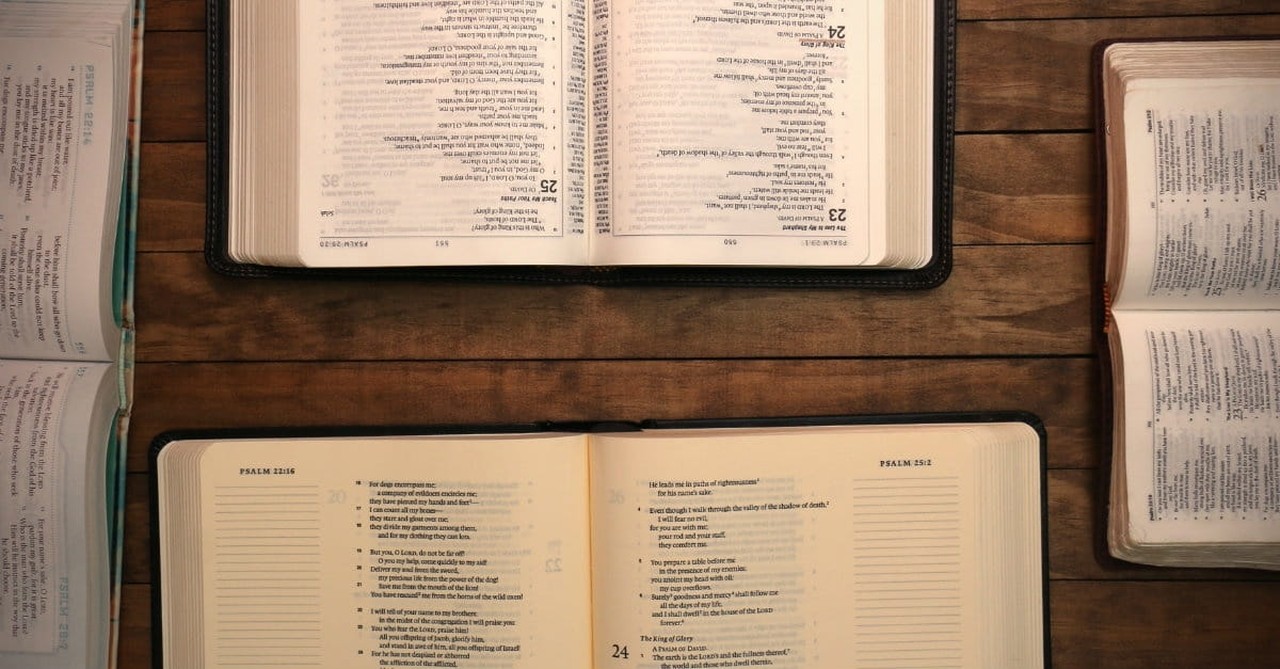
If you want to find an article to shame you into daily devotions, or adding one more thing to your spiritual to-do list, you can find plenty of them. This isn’t one of them.
Whenever the Bible talks about spending time with God through reading the Word, it’s never in the context of a burden. Just take a look at Romans 15:4, “For everything that was written in the past was written to teach us, so that through the endurance taught in the Scriptures and the encouragement they provide we might have hope.” I don’t know about you, but I could use more hope in my life.
Maybe you find it hard to consistently read the Bible, and want to know what routines or practices others have. Or maybe you’re a devoted read-the-Bible-in-one-year person but want a new technique to go along with your reading plan to keep it from falling into a monotonous routine. There’s something for everyone in this list!
Just remember: Even the most creative approach to reading the Bible is nothing compared to the realization that you are reading the words of God—out of everything he could have said to his sons and daughters, he chose these words, arranged in this way, using dozens of authors over thousands of years. That’s some motivation!
Photo credit: ©Thinkstock/kevron2001
1. Praying the Bible

1. Praying the Bible
SLIDE 1 OF 10
This method is just what it sounds like: Take a passage of Scripture and read it, line by line, pausing in between to pray its truth for specific people and situations in your life. The psalms are great for this, since they’re written as prayers. (Even the ones where David wishes death to his enemies can be turned into prayers about the destruction of sin in your own heart or evil in the world like terrorism, human trafficking, or poverty.)
This method is less about interpreting the passage and more about using its words to bring requests before God and to praise him for who He is. Try pausing between each verse and lifting up specific people and situations that relate to the words there. If you find it hard to focus in your time praying, this might be helpful for you.
Need a place to start? Try praying through Isaiah 35, Psalm 27, or Philippians 2.
Photo credit: ©Thinkstock/Arrangements-Photography
2. Studying the Names of God

2. Studying the Names of God
SLIDE 2 OF 10
There are several ways to use this method. First, you can take a month and find a list of the names of God and where they’re used in the Bible. (Check online or in one of many books on this topic.) Look at the context: what do you learn about God? Why is this name particularly meaningful in the context it was used? Why is this name meaningful to you personally? How can you praise God for the attributes this name shows?
If you use a Bible reading plan, you can also keep a special journal or even just a piece of paper where you record each new name or title for God that you find as you read. Underneath each one, jot down the reference of when it was used and the significance. At the end of the year, you’ll have a great guide to turn to when you want to read about a particular name or attribute of God. Don’t forget the “I am” statements of Jesus!
Photo credit: ©Thinkstock/elinedesignservices
3. Copying Out a Book of the Bible

3. Copying Out a Book of the Bible
SLIDE 3 OF 10
Not into the fancy flourishes and artsy lettering of Bible journaling? That’s fine. All this method requires is the ability to print letters. Pick a book of the Bible that you’ve found meaningful or one that you want to explore more deeply and purchase a blank notebook. Then, verse by verse, copy the text into your own notebook.
The idea comes from Deuteronomy 17:18-19, “When he takes the throne of his kingdom, he is to write for himself on a scroll a copy of this law, taken from that of the Levitical priests. It is to be with him, and he is to read it all the days of his life so that he may learn to revere the Lord his God and follow carefully all the words of this law and these decrees.”
Just like in that commandment, the purpose isn’t really about having a book of the Bible in your own handwriting. It’s the fact that copying the text helps focus you on the words and the truth they contain. It keeps you from skimming over the text and gives you time to absorb it.
Does this seem daunting to you? Start with a small book, like James or Philippians, or just Psalm 119. Feeling adventurous? Try John, Proverbs, or Romans and spread it out over a longer period of time.
Photo credit: ©Thinkstock/Rawpixel
4. Lectio Divina

4. Lectio Divina
SLIDE 4 OF 10
The Latin might be a clue that calling a “new” way to study the Bible is a stretch, since this has been practiced by Christians for centuries. Lectio divina is reading a passage of Scripture, usually quite slowly: a verse or even a phrase at a time. This gives you time to meditate on God’s Word.
It might sound a little mystical for the more structured types among us, but Christian meditation isn’t about emptying your mind—it’s about filling it with truth while setting aside other distractions. In a word full of chaos and noise, taking time to slow down and sit in silence is a practical way to live out God’s command in Psalm 46:10: “Be still and know that I am God.”
Photo credit: ©Thinkstock/Ruslanshug
5. Finding Jesus in the Old Testament

5. Finding Jesus in the Old Testament
SLIDE 5 OF 10
Jesus isn’t just in the Gospels… but don’t take my word for it! In John 5:39, Jesus tells the Pharisees (the top scholars of the day), “You study the Scriptures diligently because you think that in them you have eternal life. These are the very Scriptures that testify about me.” Jesus also repeatedly said that he fulfilled the Law and the Prophets (Luke 24:44, Matthew 5:17). You can read the Old Testament over and over, but if you miss seeing Jesus there, you’ve missed the point.
I love the story after the resurrection, where Jesus (in disguise) tells two of his disciples, “‘Did not the Messiah have to suffer these things and then enter his glory?’ And beginning with Moses and all the Prophets, he explained to them what was said in all the Scriptures concerning himself.” (Luke 24:26-27)
When you read the Old Testament, look for Jesus, starting way back in Genesis 3, where God promised a descendant of Eve would crush the serpent, Satan. How do the histories, like the covenant with Abraham or the Passover, foreshadow the sacrifice of Jesus? Where do the prophets speak about him? What do we learn about our need for a redeemer in Judges or Ruth? Ask these questions as you read, and you’ll be sure to discover something new.
Photo credit: ©Thinkstock/southtownboy
6. Distinguishing Paul's Letters

6. Distinguishing Paul's Letters
SLIDE 6 OF 10
Sometimes (admit it) all of Paul’s letters can get mixed up in our minds. Here’s one way to help distinguish them: Commit to reading through all of Paul’s letters. Give yourself a week for the shorter ones, a few weeks for the longer ones.
Before you start each letter, jot down these details, using either a study Bible or another Bible reference tool.
- Who was this written to?
- Context (what do we know about what was happening at the time it was written)
Then, as you read, fill in the following:
- Key words/phrases
- Key verses
- Verses that stood out to you personally
- If you had to sum up the most important theme of this book in one sentence, what would it be?
When you’re finished, you’ll have a handy guide to help keep all of the letters straight—and that will make books and sermons more meaningful to you.
Photo credit: Unsplash.com
7. Walk with Jesus through the Gospels

7. Walk with Jesus through the Gospels
SLIDE 7 OF 10
My friend once gave me this advice: If you’re going through a spiritually dry time, read through the Gospels and write down what you learn about Jesus.
That’s it. Nothing fancy. It seems so simple that it can hardly be called a “method,” but at the same time… how often do we page right by the familiar stories of miracles and parables? How long has it been since we let Jesus surprise us? When we ask what it means to follow Jesus today, do we have a clear picture of what that looks like?
All of that and more can be found when taking this exercise through each of the four Gospels. As Christians, we’re called to be disciples and imitators of Jesus. The best way to know what your faith should look like is to get to know him better.
Photo credit: ©Thinkstock/catalby
8. Topical Study

8. Topical Study
SLIDE 8 OF 10
Pick a specific topic that you want to learn more about. Look up every time the Bible references that word (or related words). You can do this using a concordance or a Bible app or website (like biblestudytools.com). There may also be books, articles, and other resources that can direct you toward what God has to say on that topic, but always let them point you back to his Word.
As you study, ask yourself: what themes do you see? Is there anything in your life you feel called to change in light of these verses? Consider picking one key verse on this topic and memorizing it.
One note: Be careful to look at the context of each verse to get a fuller picture of the meaning. Gathering wisdom from the Bible on a topic can be very helpful, but it’s also easier to take a verse out of its immediate context (the verses around it) and biblical context (the full picture of what the Bible teaches).
Examples: Disciple/discipleship, money/treasure/wealth, joy, fighting temptation.
Photo credit: ©Thinkstock/Arrangements-Photography
9. Try a Tool

9. Try a Tool
SLIDE 9 OF 10
The greatest commandment includes loving God with our whole mind, and that sometimes takes extra effort on our part. We don’t want to dismiss our personal connection to the text, or what the Holy Spirit might be teaching us through the Word, but that doesn’t mean there’s no place for study in personal devotions.
Pick a tool you’d be interested in using. Buy it at your local bookstore, borrow it from your pastor, or check it out from the library. Then use it to study a particular section or book of the Bible. See what new insights you gain—you might even want to write them down in a journal.
Here are some possibilities:
- Bible Atlas: Great when you want to add to your understanding of the Exodus and wilderness wandering, Paul’s missionary journeys, and other places and movements in biblical history.
- Bible Encyclopedia: These come in many forms, like one that covers the culture and times of Jesus, or chronicles details about the Old Testament, like what the temple looked like and what the imagery in Daniel might mean.
- Commentary: Ask your pastor for a good recommendation of a readable commentary—there are many out there, and some are not as strong as others. Be sure to thoroughly read the passage first, then see what the commentator has to add about the context and meaning of the verse, including other cross-references.
Photo credit: ©Thinkstock
10. Coordinate with Your Sermon Series

10. Coordinate with Your Sermon Series
SLIDE 10 OF 10
Take a sermon series that your church is starting and dive deeply into a parallel study. If it’s exegetical (preaching straight through a book or part of a book), read the passage before the sermon on Sunday. If it’s topical and you don’t know for sure which passages you’ll be going to, pick a portion of the Bible that has a lot to say about that topic and read through it a little at a time.
This is a great weekend devotional practice to get into, and unlike some of the other methods, it is usually pretty short, since pastors don’t often tackle massive chunks of Scripture at one time. There won’t be any “spoilers” for the sermon, but it’s amazing how much easier it is to engage in church when you’ve spent time focusing your heart on the subject ahead of time.
Photo credit: ©Thinkstock/tapgoodimages
Originally published June 07, 2017.







